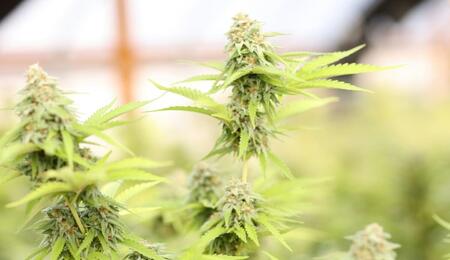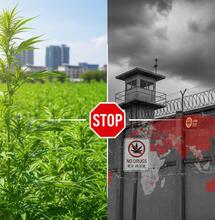September Garden Preparations

For outdoor growers, it is the beginning of harvest season. Work and time will be saved if growing and drying areas are prepared in advance.
Ah, harvest time. The air is crisp and the seasonal shift can be felt everywhere. For outdoor cultivators, though, it means only one thing - that months of hard work are to be followed by long hours of harvesting, drying and curing that carefully grown crop.
The demands of outdoor growers are often different than the challenges faced by indoor producers, but this time of year is the perfect chance for both types to pause, reflect and prepare for the end of one season and the beginning of another. The following tips are a useful reminder for all cultivators, whether amateurs or professionals, indoor or out.
Keep It Clean, Indoors and Out
One of the very most important patterns to adopt as a grower is to be constantly mindful of infestations, diseases and environmental issues. It is always a good idea to think ahead and is usually easier, and less expensive, to prevent such problems, rather than trying to correct them later.
An easy way to prevent these issues indoors is to keep all growing spaces as pristine as possible, and prepare for new crops by integrating a thorough cleaning into your grow room maintenance schedule. Make a list of what items need to be clean, as well as what sterilizing and disinfecting materials will be needed. Clean and sharpen or replace all trimming and cutting implements, be they razor blades or art knives for cutting clones, bonsai scissors used for trimming and manicuring plants or giant hedge clippers used to harvest plants.
Indoor surfaces, including any work surfaces, storage shelves, sinks, walls, floor and ceiling (if possible) should also be cleaned and sterilized regularly, and this is much more easily done when there are no plants in the way. Keep a dedicated sprayer handy with which difficult-to-reach areas may be treated, and make sure to label this sprayer so that it is not accidentally used to feed or mist your next crop. Residual cleaning products are not a nice thing to feed to your babies.
Dust off your reflectors and ballasts, as residue can accumulate over time and reduce performance. Plus, it does not make sense to clean the growing space and ignore the growing equipment. Your healthy, clean plants do not need a thick layer of dust and grime to accidentally contaminate them. This is also a good time to determine whether or not certain equipment should be replaced, such as filters.
Thoroughly scrub all plant pots and tags/labels, fans, plant clips, yoyos and other suspension devices, bamboo sticks or other plant supports, watering cans and nutrient measures. If you plan to use a strong disinfectant, such as Dettol, Lysol or bleach, be certain to rinse and dry such objects after application. If possible, try to use a natural product that will not damage the environment and ground water. Some growers prefer to use Dr. Bronner's natural soaps, while others feel that persistent infestations, for example, call for the more lethal products.
Perhaps one of the most essential cleaning tasks is the drying and trimming rooms, which should be spotless when the freshly-harvested plants are ready for hanging. Do not ruin your quality crop with a dirty processing area!
Much of this same advice should be useful to outdoor growers, although the annual clean-up can be considerably more troublesome and a lot more work, as many outdoor crops stretch across large patches of land. Temporary barriers, such as fishing line and fencing, can be dismantled and cleaned in sections before being stored for the winter. If you use a non-organic ground cover to insulate the roots, this should also be thoroughly sanitized, immediately after harvesting. Yes, this is a busy period, but a little bit of extra prevention goes a long way and will make it easier to set out the following year's crop.
Any outbuildings, such as greenhouses (and poly-tunnels) potting sheds, garages or barns, should be cleared out and given a thorough cleaning and inspection. Making these spaces ready in advance will save you time and frustration when it is time to put away the growing equipment for the season. Any large machinery, for example, earth movers or diggers used to create spacious grow plots for large outdoor plants, should be cleaned and checked or maintained as necessary. Smaller tools like shears/clippers, shovels and spades, must also be tended to, as nasty pathogens may lurk in the residual soil that is common on such items.
Organize Your Weed Growing Equipment and Stock
Have you ever gotten deeply absorbed into a gardening task, only to realize that you are missing vital pieces of equipment? How about that elusive pack of seeds that you were planning on popping? It is essential that every gardener not only know exactly what he or she has in stock, but also that a periodic check is done to ensure that everything is as it should be - and where it should be. This includes organizing your genetics, perhaps retaining a back-up in a separate location, if possible. Seeds should be stored in air-tight packaging, preferably refrigerated, that will not encourage condensation and will protect them from damage.
Broken pots, leaky watering cans and defective sprayers should be replaced. Check your nutrient stock and be sure to responsibly discard any expired products, while re-stocking items that are frequently used. It is also helpful to clean storage areas between grows, as the sticky mess created by hasty feedings or cracked receptacles can attract unwanted visitors, such as insects.
Mark a calendar with any major events that may cause you to be away from your plants over the next twelve months, and make arrangements for their care or plan your planting and harvesting accordingly.
Also read on Soft Secrets:
- What’s the Best Time to Grow Cannabis?






